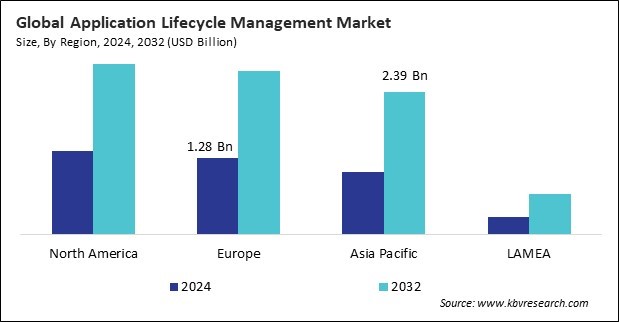According to a new report, published by KBV research, The Global Application Lifecycle Management Market size is expected to reach $8.67 billion by 2032, rising at a market growth of 10.4% CAGR during the forecast period.
The Cloud segment is leading the Global Application Lifecycle Management Market by Deployment Mode in 2024; thereby, achieving a market value of $5.19 billion by 2032. Organizations are progressively utilizing cloud-based ALM solutions to enable real-time collaboration, remote access, and seamless integration with other cloud applications. The growing prevalence of remote and hybrid work models has further boosted the adoption of cloud ALM tools, allowing distributed teams to collaborate effectively from any location.

The Small & Medium Enterprises (SMEs) segment is anticipating a CAGR of 11% during (2025 - 2032). SMEs are increasingly utilizing cloud-based ALM solutions that are cost-effective and provide scalability, flexibility, and simplicity of use. These solutions enable smaller teams to manage software projects efficiently without extensive IT infrastructure. Furthermore, the emergence of cost-effective subscription-based ALM models enables small and medium-sized enterprises to leverage sophisticated features without requiring a substantial initial investment.
The Software segment is generating maximum revenue in the Global Application Lifecycle Management Market by Component in 2024; thereby, achieving a market value of $5.32 billion by 2032. Organizations are increasingly adopting ALM software to automate project planning, development, testing, deployment, and maintenance tasks. The integration of agile and DevOps practices into ALM solutions has further enhanced their appeal, allowing teams to collaborate seamlessly and accelerate development processes. Moreover, the availability of cloud-based and on-premise software options enables businesses of all sizes to choose solutions that align with their operational requirements, driving the segment's significant revenue growth.
The BFSI segment would obtain a CAGR of 9.1% during (2025 - 2032). The increasing digitization of banking, financial services, and insurance processes drives the segment. Financial institutions require robust ALM solutions to manage complex software applications that support online transactions, mobile banking, risk management, and customer service automation. The need to ensure security, compliance, and data integrity while managing dynamic software environments drives BFSI organizations to invest significantly in ALM tools. Additionally, the growing adoption of agile and DevOps practices in financial technology further fuels the demand for efficient ALM solutions to enhance software quality and operational efficiency.
Full Report: https://www.kbvresearch.com/application-lifecycle-management-market/
The North America region dominated the Global Application Lifecycle Management Market by Region in 2024, and would continue to be a dominant market till 2032; thereby, achieving a market value of $2,856.1 million by 2032. The Europe region is experiencing a CAGR of 10.2% during (2025 - 2032). Additionally, The Asia Pacific region would exhibit a CAGR of 11.2% during (2025 - 2032).
By Deployment Mode
By Component
By Organization Size
By Vertical
By Geography
 Unique Offerings
Unique Offerings